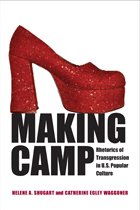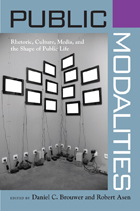2 books about Shugart, Helene A.

Making Camp
Rhetorics of Transgression in U.S. Popular Culture
Helene A. Shugart and Catherine Egley Waggoner
University of Alabama Press, 2008
The rhetorical power of camp in American popular culture
Making Camp examines the rhetoric and conventions of “camp” in contemporary popular culture and the ways it both subverts and is co-opted by mainstream ideology and discourse, especially as it pertains to issues of gender and sexuality.
Making Camp examines the rhetoric and conventions of “camp” in contemporary popular culture and the ways it both subverts and is co-opted by mainstream ideology and discourse, especially as it pertains to issues of gender and sexuality.
Camp has long been aligned with gay male culture and performance. Helene Shugart and Catherine Waggoner contend that camp in the popular media—whether visual, dramatic, or musical—is equally pervasive. While aesthetic and performative in nature, the authors argue that camp—female camp in particular—is also highly political and that conventions of femininity and female sexuality are negotiated, if not always resisted, in female camp performances.
The authors draw on a wide range of references and figures representative of camp, both historical and contemporary, in presenting the evolution of female camp and its negotiation of gender, political, and identity issues. Antecedents such as Joan Crawford, Wonder Woman, Marilyn Monroe, and Pam Grier are discussed as archetypes for contemporary popular culture figures—Macy Gray, Gwen Stefani, and the characters of Xena from Xena: Warrior Princess and Karen Walker from Will & Grace.
Shugart and Waggoner find that these and other female camp performances are liminal, occupying a space between conformity and resistance. The result is a study that demonstrates the prevalence of camp as a historical and evolving phenomenon in popular culture, its role as a site for the rupture of conventional notions of gender and sexuality, and how camp is configured in mainstream culture and in ways that resist its being reduced to merely a style.
[more]

Public Modalities
Edited by Daniel C. Brouwer and Robert Asen
University of Alabama Press, 2010
Illustrates a modalities approach to the study of publics
This book explores the ways that scholars, journalists, politicians, and citizens conceive of “the public” or “public life,” and how those entities are defined and invented. For decades, scholars have used the metaphors of spheres, systems, webs, or networks to talk about, describe, and map various practices. This volume proposes a new metaphor—modalities—to suggest that publics are forever in flux, and much more fluid and dynamic than the static models of systems or spheres would indicate—especially in the digital age, where various publics rapidly evolve and dissipate.
Contributors to the volume—employing approaches from the fields of communication studies, English, sociology, psychology, and history—explore a broad range of texts and artifacts that give rise to publics, and discuss what they reveal about conceptualizations of social space. By focusing on process in public engagement, these scholars highlight questions of how people advance their interests and identities, and how they adapt to situational constraints.
Bringing together scholars in rhetorical, cultural, and media studies, this collection of new case studies illustrates a modalities approach to the study of publics. These case studies explore the implications of different ways of forming publics, including alternative means of expression (protests, culture jamming); the intersection of politics and consumerism (how people express their identities and interests through their consumer behavior); and online engagement (blogs as increasingly important public fora). In doing so, they raise important questions of access, community, and political efficacy
This book explores the ways that scholars, journalists, politicians, and citizens conceive of “the public” or “public life,” and how those entities are defined and invented. For decades, scholars have used the metaphors of spheres, systems, webs, or networks to talk about, describe, and map various practices. This volume proposes a new metaphor—modalities—to suggest that publics are forever in flux, and much more fluid and dynamic than the static models of systems or spheres would indicate—especially in the digital age, where various publics rapidly evolve and dissipate.
Contributors to the volume—employing approaches from the fields of communication studies, English, sociology, psychology, and history—explore a broad range of texts and artifacts that give rise to publics, and discuss what they reveal about conceptualizations of social space. By focusing on process in public engagement, these scholars highlight questions of how people advance their interests and identities, and how they adapt to situational constraints.
Bringing together scholars in rhetorical, cultural, and media studies, this collection of new case studies illustrates a modalities approach to the study of publics. These case studies explore the implications of different ways of forming publics, including alternative means of expression (protests, culture jamming); the intersection of politics and consumerism (how people express their identities and interests through their consumer behavior); and online engagement (blogs as increasingly important public fora). In doing so, they raise important questions of access, community, and political efficacy
[more]
READERS
Browse our collection.
PUBLISHERS
See BiblioVault's publisher services.
STUDENT SERVICES
Files for college accessibility offices.
UChicago Accessibility Resources
home | accessibility | search | about | contact us
BiblioVault ® 2001 - 2024
The University of Chicago Press









